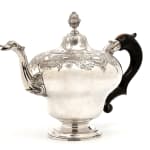João Coelho Sampaio
Further images
Important Portuguese silver teapot, D. José (king 1750-1777), smooth circular base, inverted pear-shaped body, with the lower part undecorated, swan neck spout, topped with a swan beak, the entire upper part and the lid at body level, with rocaille decoration, engraved, repoussé and carved in foliage, flowers – marigolds and chrysanthemums – shells, fins and volutes. Pinecone-shaped button. Rosewood handle carved in the shape of a “C”, joining the body with foliage wrapping.
Although initially there were no differences between pieces for coffee and tea, or even hot chocolate, from the end of the 17th century/ beginning of the 18th, these begin to distinguish themselves and individualize themselves.
Coffeepots become taller and narrower, just like chocolate pots, with some differences in the side handles and lids.
On the other hand, teapots become lower and wider, in shapes inspired by the sphere, the pumpkin or the inverted pear.
Once these formats are stabilized, they will remain similar, with few changes for centuries.
Like this elegant, inverted pear-shaped teapot by the silversmith João Coelho Sampaio
Note: The consumption of coffee and tea since the mid-17th century led to the creation of specific containers for its service







